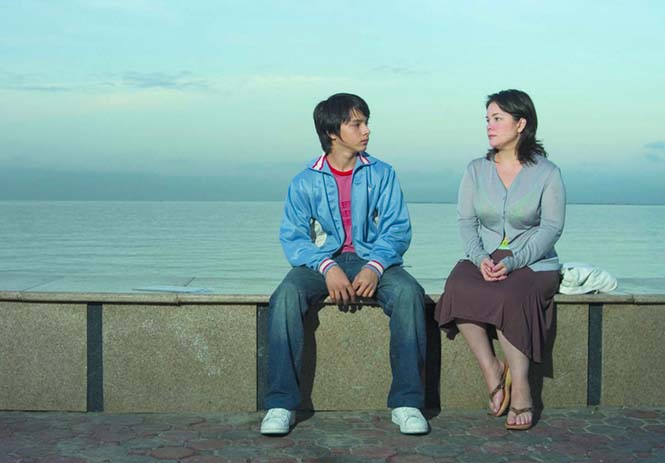For those in the know, Puerto Galera’s White Beach in Oriental Mindoro is no tropical paradise – in fact, parts of it (i.e. the middle portion, where the partying happens) are reminiscent of the… dilapidation of Thailand’s Phuket and Patong. Yes, yes, the sand is finer (and whiter/cleaner), the water clearer (at times even reflecting the azure sky) in Puerto Galera, but – arguably particularly during peak season – the feel is somewhat similar.

Part of Puerto Galera’s appeal (or what may well be disappointing about it, depending on how one looks at it) are the activities that happen at the bars when the sun sets – from go-go boys to drag shows to fire dancers to… just about everything. That a lot happens here is an understatement.
There are the overcrowded restos, offering too expensive food (e.g. kebab that used to sell for P80 to P90 now selling from P160; and buko that – even in capital Metro Manila – sells for P25 sold here for from P50).
Bars that try to squeeze the last cent off you (e.g. Mindoro Sling that used to sell for P400 per pitcher now selling for P750, even if the raw materials used to make them remain roughly the same).
The half-naked go-go boys dancing on the stages and MSM plying the beach when the sun sets, many of them from the nearby some small towns, here to make a (lousy) living.
Impoverished transwomen also trying to eke out what they have until they find something that will last longer.
Fire dancers basically begging off tips from tourists to add to their monthly earnings that only reach P3,000.
Some women trying to catch the eyes of visitors (particularly foreigners who frequent the place for the diving).
Yes, this can be tropical paradise for the moneyed.
For the less moneyed, it’s a venue worth visiting maybe for the weekend, to escape the hustle and bustle of (not too far) Metro Manila.
But for the broke… it’s a different story altogether.
But then, Puerto Galera offers glimpses of what resort living could be.
Enter the likes of Coco Aroma.
Located at the far left side of the island (when you’re standing on White Beach while facing the sea), this resort cum restobar is the “baby” of Cora M. de Veyra and her husband Joel artist who – after inheriting the piece of land from her mother – transformed it into a hub for the “alternative” tourists.
Think reggae, light rock and blues.
Think masks carved on driftwood.
Think dreadlocks.
Think wooden construction materials.
Think hammocks by the sea.
Coco Aroma is divided into two areas – the restobar AND the cottages.
The rooms are located in the garden. Note that there are only five rooms available – i.e. three aircon rooms (one room on the ground floor that’s good for four, and two rooms on the second floor good for two); and two fan rooms (in a duplex) good for four persons. The rooms are – largely – made of nipa (that is, traditional thatched roofed housing). As owner Cora would describe it, “lokal na lokal (truly local).” Room rates vary according to season.
An insider info: there are budget spaces available – i.e. attic rooms offered for the budget conscious; though the rates also vary according to season.

Coco Aroma offers an alternative venue for those who want to experience Puerto Galera as a tropical paradise.
The restobar area is – by itself – a must-visit.
There are cabanas (which, by the way, are what visitors would first see when seeing Coco Aroma by the beach) with five tables (and a hammock) that could seat up to 30 people; five tables in the middle portion that could seat 20 more; and two tables on a verandah-like setting facing a stage that could seat approximately 10. Lying down on the cabana’s wooden floor, lazy lounging easily comes to mind. Interestingly, “ginawa namin ang cabanas the way they are para kung malalasing ka, diyan ka na matutulog (we made the cabanas the way they are so when guests get drunk, you can already sleep there),” Cora laughed.
Particularly during summer, there’s live music in Coco Aroma (usually helmed by the house band named Turtle Club, “who you can jam with,” Cora said), covering reggae, rock, blues. There’s also bonfire in summer.
Yes, drinking (and… smoking) is what comes to mind when at Coco Aroma (heck, there’s a poster of Mona Lisa with a joint on the bar’s wall), so worth considering are Coco Aroma Sling (the venue’s version of the Mindoro Sling, in itself a take on Singapore Sling) and the bottomless Margarita. But even though the sun’s till up (think late afternoons), hanging out here is fun while chewing the house specialties fruit pancakes (flavors include banana, mango and choco banana) at P185; any of the curried dishes (e.g. vegetable curry at P150, and curried tofu at P120); and pansit (noodles) from P180. Watching the sun set away from the crowd while slowly sipping kapeng barako (brewed coffee using local beans) is an option worth considering (versus ice cold beer in hand).
It’s a venue allowing one to experience the best of both worlds – as a manner of speaking.
That is, for those who know that there is fun in the dilapidated (I’d admit, sleaze can be fun, too), yet also know that hearing Bob Marley’s calming voice is akin to being lazy by some beach somewhere, then Coco Aroma’s the place that pops in the mind when one is in Puerto Galera.
Because for all its seeming dilapidation, Puerto Galera’s still worth a visit.
If you just know that fun has many incarnations when there…
For more information on Coco Aroma, contact Cora M. de Veyra at (+63) 9166167337, (+63) 9194728882 or (+63) 9232187399; email cocoaroma_5203@yahoo.com; visit www.cocoaromapg.com or www.cocoaromawhitebeach.com; or Coco Aroma’s Facebook page.






















































































